UI/UX design is a multidisciplinary field, where it is getting increasingly important for designers to develop many skills. These skills range from using software and tools to conducting research and analysis.
Understanding human-computer interaction requires various skills, which is why the field of design is constantly evolving, finding more and more avenues for collaboration between different disciplines. Cognitive psychology is one such domain that is of immense help to designers.
When designing a user interface, it is crucial to consider the psychological and behavioral elements involved in the process of design and interaction so that the users can get a quality experience.
UX design psychology deals with this aspect, which cannot be overstated. For this reason, any UX design agency pays attention to the principles of psychology and human behavior in design.
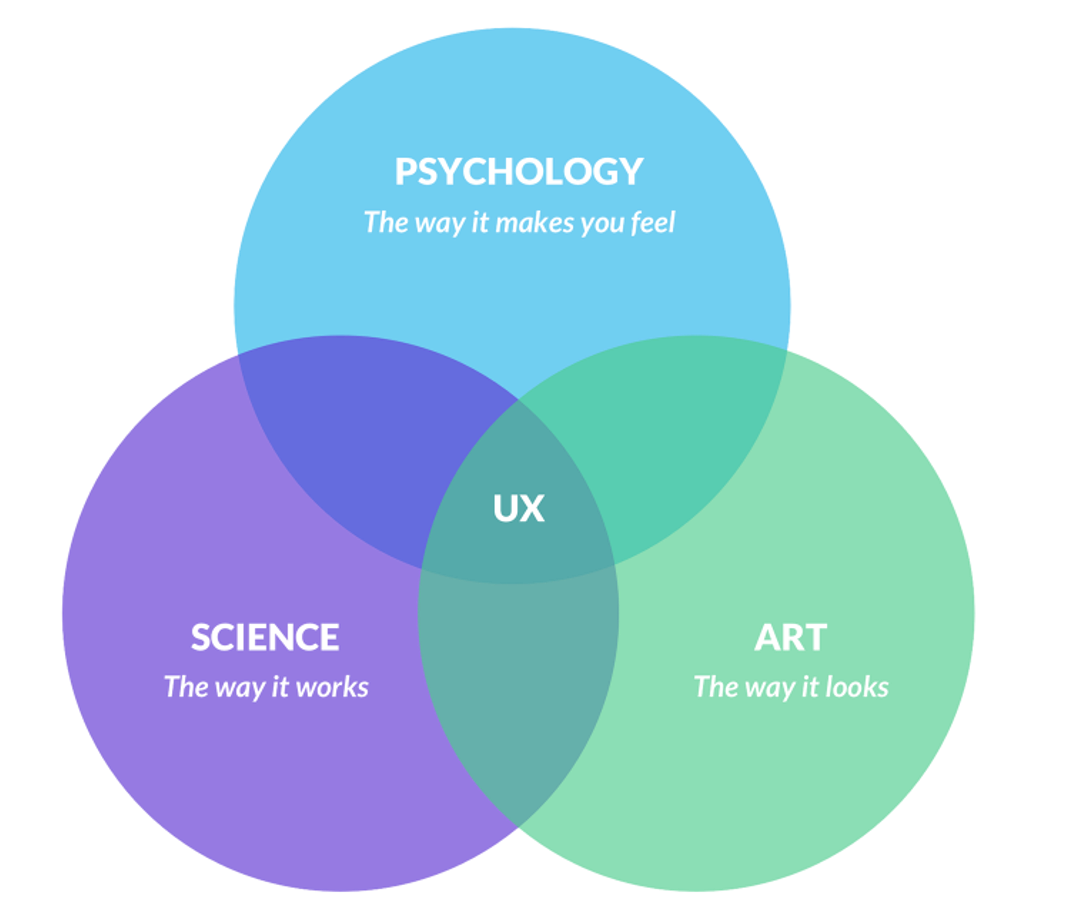
Psychology and UX Design (InVision)
In this article, we explore the concept of psychology in design to understand how user experience is influenced by and dependent on psychological principles. We introduce the benefits of psychology experience in design and the essential principles of psychology in UX design. We also discuss Gestalt principles in visual design toward the end.
Read along as we introduce this interesting multidisciplinary topic, which is extremely important for a UX designer.
Understanding Psychology in UX Design
When the users interact with a product or service, they invest their emotions, energy, thoughts, time, and effort. This means that the users get involved with the designs on a deeper level, developing certain behaviors and attitudes that then dictate their decisions.
For UI/UX designers, it is vital to understand the user psychology and cognitive bias leading up to their choices and behaviors. This is where design psychology becomes crucial for products and services, particularly those in the digital environment.
Partnering with a UX design consulting firm allows organizations to integrate behavioral psychology into their design process. From cognitive load analysis to A/B testing, these experts ensure that psychological principles inform every stage of user experience design.
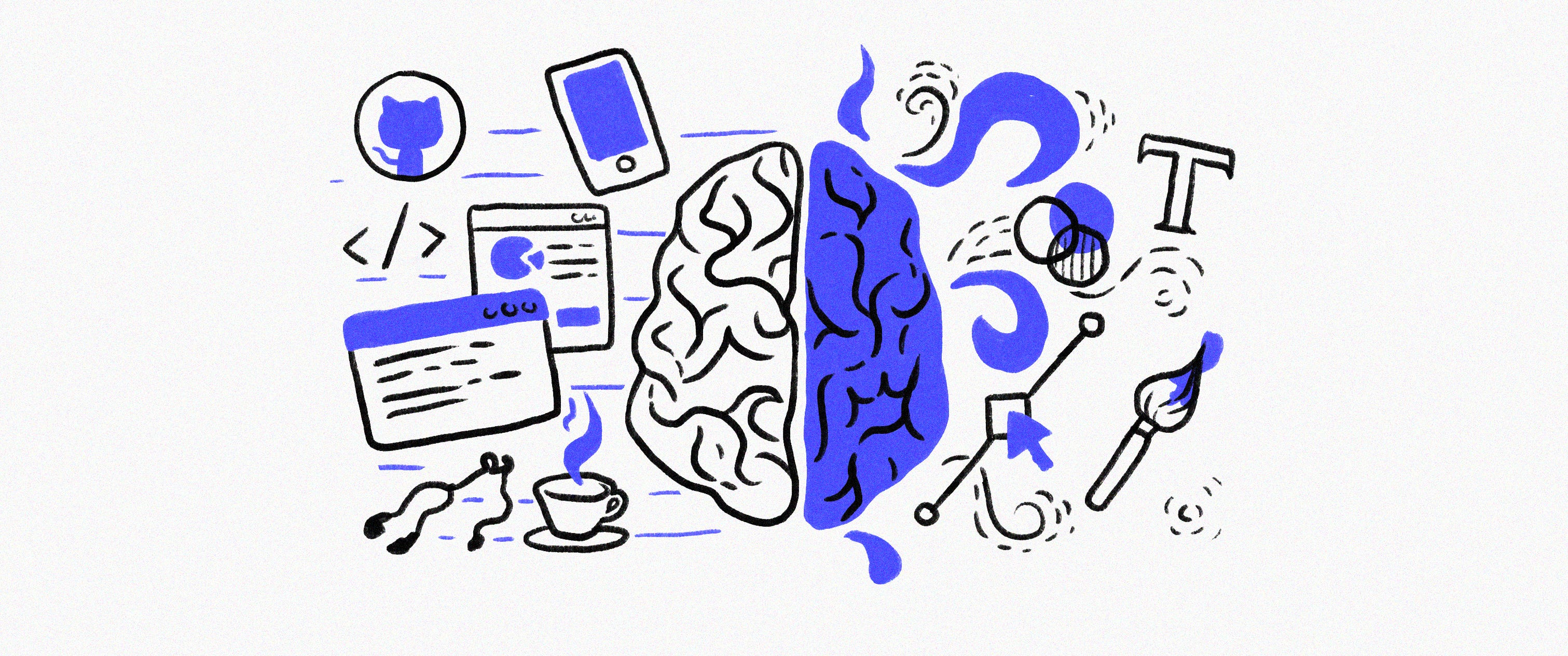
Relationship between Psychology and UX Design (Beanes Diogo on Medium)
The psychological aspects and elements of any design have a varying range. These include but are not limited to cognitive load, design narratives, the impact of visual elements, aesthetics, and the flow of the user journey. The designs of products and services can be significantly improved by focusing on psychological principles.
Importance of Psychology Experience in UX Design
At this point, it is essential to highlight why UI/UX professionals need to focus on psychology experience in design. It is critical to note that user experience encompasses the overall interactions with and feelings toward a particular product or service.
Therefore, the value of emotions, attitudes, and behaviors must be considered. Focusing on issues such as cognitive overload in UX design psychology is essential.
What is the importance of psychology in UX design?
Focusing on psychology can help designers in many ways.
- Understanding how people think
- Focusing on emotions and behaviors
- Designing a quality user experience
Some of the most important reasons for employing cognitive psychology in design are as follows.
Understanding how people think
The knowledge of psychology helps in understanding how human beings think about their problems and what are the ideal solutions for them. The depth and research required for developing this understanding result in valuable insights for designers.
When designers understand their users' thought processes, they can better relate to the issues and, thus, develop more effective solutions. This knowledge informs the design process, giving due attention to user desires and needs.
Focusing on emotions and behaviors
The psychological aspect of design also helps in highlighting human behaviors and emotions. For UI/UX designers, focusing on people's feelings is essential. Since user experience is a holistic term that has much to do with the level of satisfaction, a user gets when interacting with a product.
Feelings cannot be ignored in the design process. When designers develop some understanding of human behavior and psychology, they are better equipped to cater to the emotional needs of their users.
Designing a quality user experience
On a broader scale, incorporating the knowledge of psychology into user experiences helps design effective interactions. The focus on the user journey flow and the impact of micro and macro interactions on people's emotions helps create an overall satisfying experience for the target audience.
It is also important to note that the knowledge of psychological principles ensures that the designers treat different audience groups uniquely, where audiences' specific needs take priority over a generalized solution.
Benefits of Psychology Experience in UX Design
If we look at the overall experience, it is possible to acknowledge the importance of design psychology and the significance of psychological principles in creating practical and valuable interactions.
UX design psychology brings a new dimension to the field of user experience that can be leveraged in various ways to improve the design processes and the interactions of people with products and services.
What are the benefits of psychology in UX design?
There are several ways in which psychological aspects of an experience can help improve UX design.
- Understand interactions at a deeper level
- Leverage users' attitudes and behaviors
- Improve the overall user experience
Some of the essential benefits of paying attention to psychology experience in UX design are discussed below.
Understand interactions at a deeper level.
The principles of psychology bring a deeper understanding of micro and macro interactions with products and services. If designers pay attention only to the surface-level interactions of a user interface, they will never be able to make the most out of the design process.
However, when they understand human psychologies beyond mere touchpoints and metrics, they can understand the significance of design elements in an interface.
Leverage users' attitudes and behaviors
A deeper understanding of interactions requires that UX designers pay due attention to the attitudes, emotions, and behaviors of the target audience. User experience is about more than just accomplishing a task and meeting the material user needs.
Instead, designs significantly impact user behavior, driving them toward or away from a product or service. Understanding human behavior can help designers leverage the habits and attitudes of people so an overall successful user experience is created.
Improve the overall user experience.
UI/UX design is a multidisciplinary field where knowledge from different areas comes together. These include but are not limited to graphic design, technical communication, human-computer interaction, and psychology.
Leaving psychological aspects out of the design process would have a destructive impact on the general nature of user experience, reducing user satisfaction. It is, therefore, essential to consider the importance of psychological and behavioral factors in UX design and the material aspects of design.
Behavioral Considerations in UX Design
Now that we've established the importance of psychological aspects for UX design, we can look at a few significant behavioral considerations for designers working on their projects.
When designers note essential behavioral elements, they can ensure that the working memory capacity of users is utilized in the best way possible. Good designs are the ones that reduce cognitive load and make life easy for users.
What are some essential behavioral considerations for UX design?
Some of the critical behavioral considerations for UX design are as follows.
- Positive reinforcement and encouragement
- Habit formation
- Social proof
- Loss aversion
- Increased user control
The most critical behavioral considerations that can help improve the overall user experience are discussed below.
Positive reinforcement and encouragement
One of the exciting things about human psychology is that people appreciate and are encouraged by positive reinforcement. This attitude can be seen in almost every aspect of life.
UI/UX designers can leverage the power of positive reinforcement and ensure that the overall experience is engaging and helpful for the target audience. This practice is quite common in the apps used by organizations where the progress of individual employees is tracked and presented positively.
Habit formation
Another essential behavioral consideration for UI/UX designers is habit formation. It is easy to retain users once they've developed a habit of using a specific product or service. Habit formation, however, is a slow and complex process.
This is where designers must combine positive reinforcement with habit formation, ensuring users get a satisfying overall experience. The best example of this consideration is in fitness applications, where the users develop strong habits without utilizing much working memory.
Social proof
We live in a world that is highly engaged and social. In such a digital environment, it is only logical for human nature to crave social interactions and proof on a broad level. This is where social proof is critical in UX design.
This consideration is applied by several applications and websites, where testimonials, reviews by other people, and the options of sharing progress with friends are pretty standard. All these aspects help the users meet their psychological and social needs, making the experience engaging and effective.
Loss aversion
Regarding cognitive psychology, it is interesting to see how the human brain is programmed. One exciting aspect is that people tend to avoid losses much more than they are attracted to gains. This is an essential takeaway for designers, where they can create the experience and design the user journey so their audience does not encounter loss.
Increased user control
The psychological aspects of UX design will only be beneficial if there is a discussion on user control.
The advancements in psychology and human-computer interaction have revealed that increased user control leads to better overall user experience. This is an important consideration for designers, where they can make the interactions flexible enough for users to control the journey.
Psychological Principles in Digital Product Design
Bringing a psychological perspective to the UI/UX design field requires that designers not only develop some understanding of how humans process information and how the brain works but also draw logical connections with the existing principles and processes in design.
It is vital to look at the basic psychological principles for designing effective products, particularly in the digital environment.
What are the critical psychological principles in digital product design?
The most important psychological principles for digital product design are as follows.
- Reduce cognitive load
- Match the real-world models
- Rely on recognition and familiarity
- Tell a story with your design
- Create a learning experience
- Improve the aesthetics
Some of the critical psychological principles in this regard are as follows.
Reduce cognitive load
The first and foremost principle deals with cognitive load in design. Cognitive load refers to the mental effort users require and the extent to which they must use their working memory when interacting with a product or service.
The designers aim to reduce this cognitive load and ensure users get a satisfying and comfortable experience.
Match the real-world models.
Regarding the amount of mental effort required for interaction, mental models of designs play a critical role. To save users from cognitive overload,
UI/UX professionals ensure that their products or services' physical models and methods match those of mental models inside users' brains. This makes the interaction more natural and valuable for the audience.
Rely on recognition and familiarity.
Another crucial psychological principle that UX designers often use is the reliance on recognition and familiarity in design. During an interaction, it is more challenging for users to remember and recall information than to recognize the information being presented.
The latter ensures the cognitive load is reduced and the person's working memory is utilized efficiently.
Tell a story with your design.
We, being humans, depend a lot on stories and narratives. When designers tell stories with their designs, they have a better chance to capture the user's attention and to do so for a longer time.
Similarly, a strong narrative can help direct user attention to the right areas, making the journey and interaction more effective. This is where the serial position effect also comes into play, where placing and presenting the right information correctly can lead to fruitful results.
Create a learning experience.
In the digital environment, with so many products and services being launched daily, it takes time and effort to take time out and learn new things. The users prefer to spend less processing power and working memory learning new features.
It is, therefore, essential to treat all users as learners so that designers use their existing knowledge and provide them with the right information at the right time. This will save the users from an extraneous cognitive load, making the experience helpful and not frustrating.
Improve the aesthetics
The impact of aesthetics on any design must be balanced. UX designers always ensure that the aesthetic usability effect of their design is up to the mark so the first impression of the product or service is impactful.
The aesthetic aspects are also important when the users start interacting with a design more frequently so that the visual design and interface do not negatively impact their overall experience. This goes well with human psychology and cognition principles, where we are always attracted to aesthetically pleasing things.
Gestalt Principles in Visual Design
Visual elements play a critical role in the design, particularly regarding the psychological impacts of any design. Therefore, visual design is essential in design psychology, as the human brain responds to visual stimuli.
One job of a UX designer is to create a visual identity and impression of the product or service. This is where developing an understanding of the Gestalt principles comes in handy.
What are the Gestalt principles in visual design?
The most important Gestalt principles for visual design are as follows.
- Closure
- Proximity
- Common region
- Similarity
- Symmetry
There are several important Gestalt principles for visual design. Some of the most important ones for UX designers that go well with human psychology in product interaction are as follows.
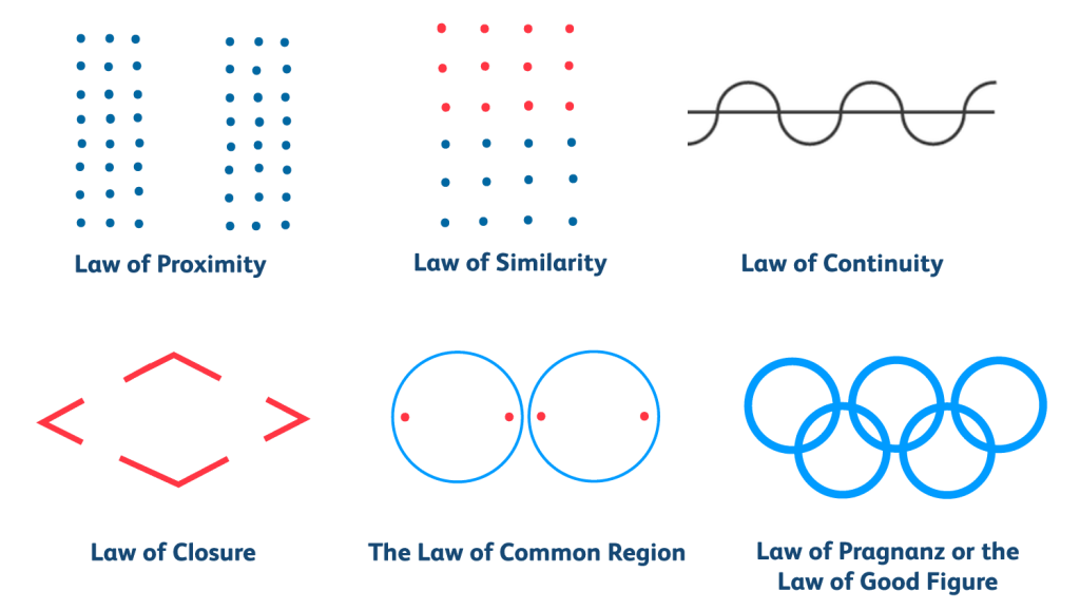
Gestalt Principles and UX Design (Design by Iconica)
Closure
The human brain does not like incomplete information and strives to fill gaps. This is where the closure principles of design can be applied. Incomplete shapes and logos are leveraged to draw attention to specific content and make the users a part of the meaning-making process.

Closure Principles in Design (Zenetic)
Proximity
Proximity, as the name indicates, refers to the positioning of objects and their closeness in any space. Designers can leverage this principle by positioning and aligning objects to make them more prominent.
This can be useful when users receive much visual and textual information and need to group and prioritize content.
Common region
Common region or common fate is another important Gestalt principle in UX design. This is where designers add more context and scaffolding to draw attention to elements grouped.
Providing the common region aspect is an add-on that makes particular objects look similar or closer to each other, thus making it easy to perceive them as a group.
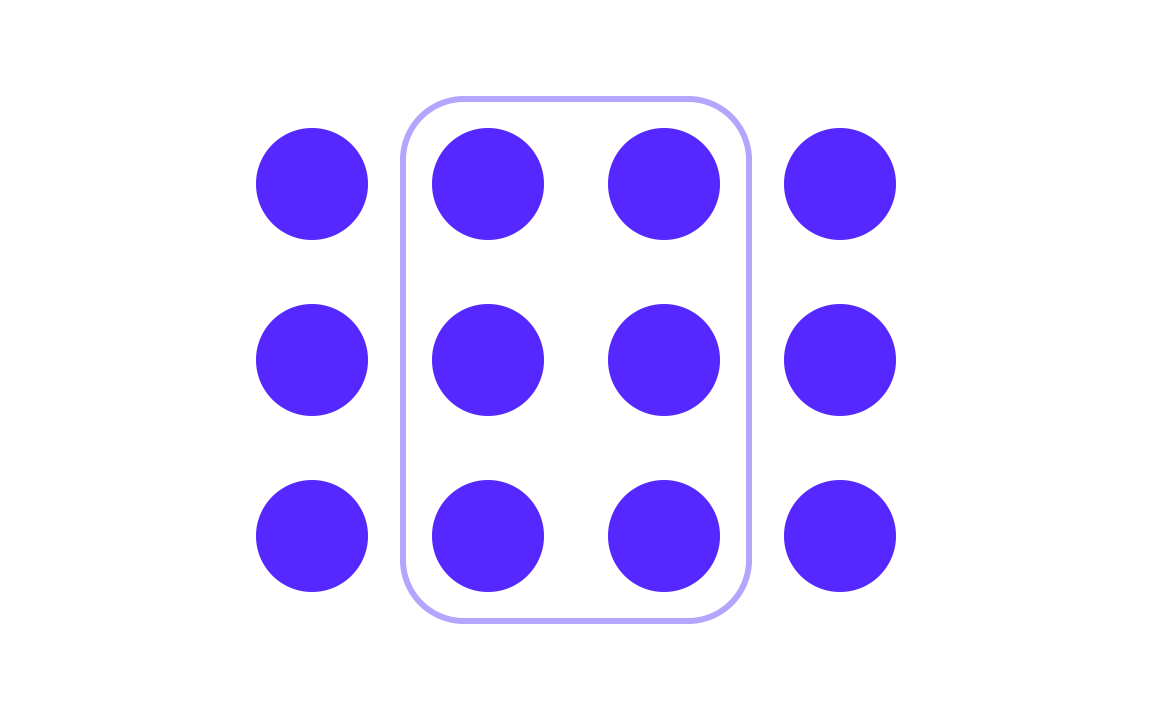
Common Region or Fate in Design (Uxcel)
Similarity
The similarity is an important visual cue used by UX designers. When elements are grouped, it gets more accessible for the audience to classify them and understand the general information. This principle is also essential in isolating objects and differentiating between them, using the Von Restorff effect.
According to the Von Restorff effect, the audience can easily separate a significantly different entity from a group of elements – something designers can use to draw attention to specific interaction points.
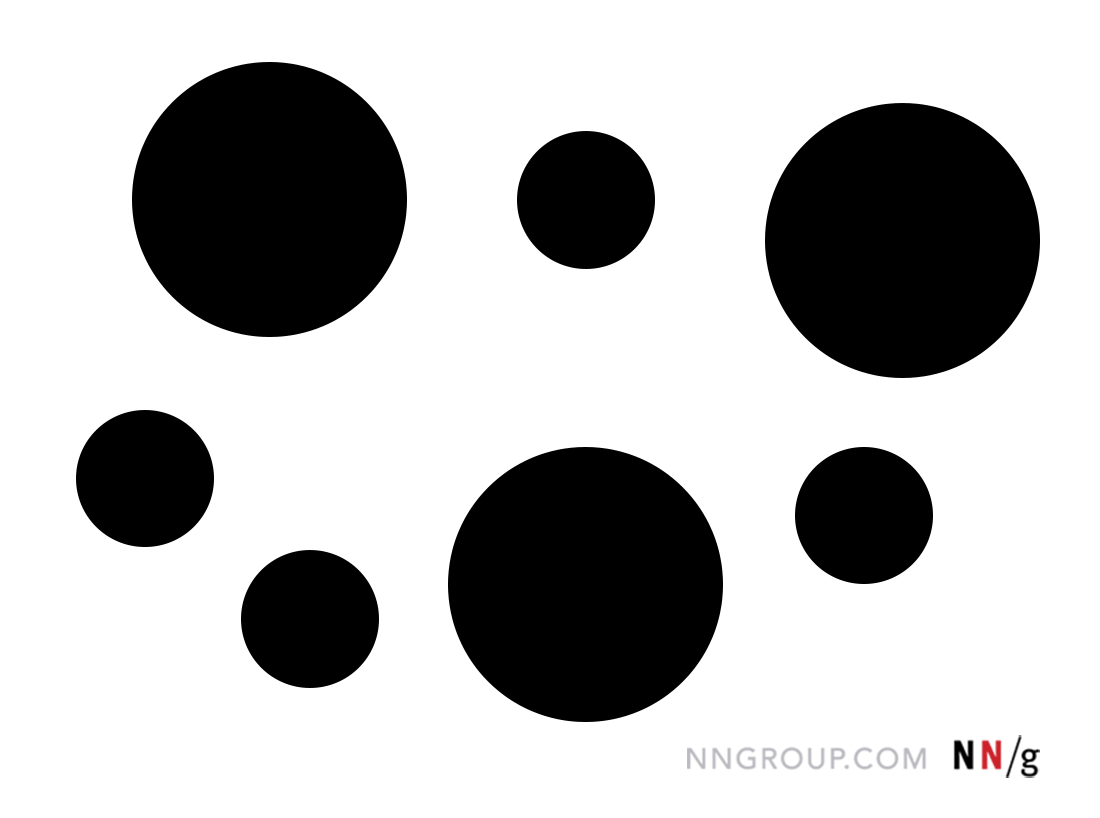
Similarity Principle for Designers (Nielsen-Norman Group)
Symmetry
Symmetry is another critical Gestalt principle that uses the Von Restorff effect. According to this principle, the objects that look similar are perceived as a group, irrespective of their proximity. Designers widely apply this principle to create visual hierarchy principles and ensure that the audience gets the right information in the right way.
Implementing Psychological Principles for Effective UX Design
Now that we've covered the principles of design psychology and their significance in the UX design process, let us review some of the best practices for designers aiming to create compelling products and services.
If you are a UX designer, understanding psychology principles is only half the task; it is essential to recognize when and how to apply these in your projects.
Some of the best for designers, creating attractive patterns and meaningful interactions with the help of psychological principles, are as follows.
Conduct thorough research
Designers need to conduct thorough research through processes such as user testing and market analysis to get a good understanding of how people think and process information.
Do not aim for a formal degree
You do not need a psychology degree to understand human psychology for design in great detail. Just like you can understand physics, at least the basics, without taking formal degrees, the basics of design psychology play the same role for UX professionals.
Develop empathy for users
Designers need to develop a sense of compassion so that they can understand user pain points in a better way. Empathy goes a long way, helping designers create practical, functional products.
Value the power of storytelling
Human cognition relies a lot on narratives and storytelling. UI/UX designers should always make a strong narrative, leveraging the serial position effect, to ensure the overall experience is satisfying.
Find a balance between intuition and data
To provide comprehensive information to the users, it is essential to balance intuitive knowledge and the importance of data. Human thinking draws from both sources, and users tend to appreciate a design that uses a mix of these strategies.
Remember the value of aesthetics
We all love products and services that are aesthetically pleasing, particularly in the digital world. It is, therefore, essential to give due attention to the visual details and create impactful, visually appealing designs.
Conclusion
Psychology and psychological principles have a lot to do with the UI/UX design field. As discussed above, it is necessary to pay attention to the impact of emotions, attitudes, and behaviors when working on the designs of products and services.
It is, therefore, critical for designers to develop some understanding of psychological principles relevant to users' emotional journeys. The above principles can be a great starting point for UX designers looking to expand their knowledge and improve their designs by developing empathy for the users.
Jun 21, 2023
